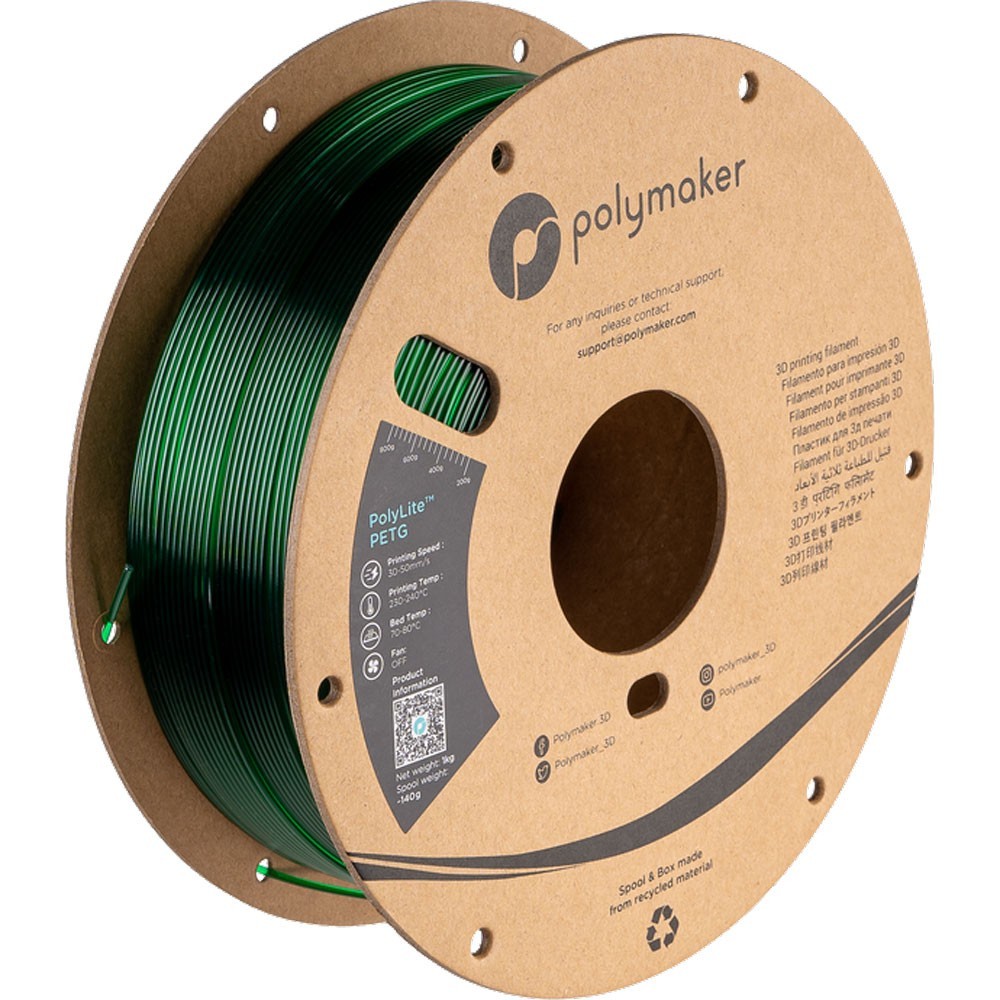
- Out-of-Stock
Polymaker PolyLite Translucent PETG
- Polymaker PolyLite Translucent PETG
- Density 1.25 g/cm3
- Tensile strength 31.9 MPa
- Elongation at break 6.8 %
- Printing Temperature 230˚C - 240˚C
- Bed Temperature 70˚C - 80˚C

Polymaker PolyLite Translucent PETG is a high-performance filament renowned for its versatility, strength, and ease of use in 3D printing. Whether you're a hobbyist, professional, or educational institution, PolyLite Translucent PETG offers a perfect blend of durability, aesthetic appeal, and printability. In this article, we'll delve into the key properties, benefits, and best practices for using PolyLite Translucent PETG.
The density of PolyLite Translucent PETG stands at 1.25 g/cm³, which contributes to its solid structural integrity while maintaining a lightweight profile. This property makes it ideal for creating sturdy yet manageable parts and models.
With a tensile strength of 31.9 MPa, PolyLite Translucent PETG exhibits remarkable resistance to breaking under tension. This high tensile strength ensures that printed objects can withstand substantial stress, making it suitable for functional prototypes, mechanical parts, and end-use products.
PolyLite Translucent PETG offers an elongation at break of 6.8%, indicating a balance between rigidity and flexibility. This characteristic allows for some degree of stretching and bending before breaking, which is advantageous for parts that require a slight flex without compromising structural integrity.
The recommended printing temperature range for PolyLite Translucent PETG is between 230˚C and 240˚C. This range ensures optimal extrusion and layer adhesion, resulting in high-quality prints with minimal defects.
A heated bed temperature between 70˚C and 80˚C is advised to prevent warping and ensure good adhesion to the build plate. Proper bed temperature is crucial for achieving smooth and precise first layers, which sets the foundation for a successful print.
PolyLite Translucent PETG is known for its clarity and shiny finish. The translucent nature of this filament allows for the creation of visually appealing parts that are perfect for applications requiring light transmission or a sleek, polished look. This makes it ideal for decorative items, display models, and lighting fixtures.
One of the standout features of PolyLite Translucent PETG is its ease of use. It prints smoothly with minimal warping, stringing, or oozing, making it accessible for both beginners and experienced users. Its compatibility with most FDM/FFF 3D printers adds to its convenience.
The combination of high tensile strength and moderate elongation at break ensures that parts printed with PolyLite Translucent PETG are durable and reliable. This filament can withstand mechanical stress and impact, making it suitable for functional parts and prototypes that require robust performance.
PolyLite Translucent PETG offers excellent resistance to chemicals, including acids, alkalis, and oils. This property makes it a preferred choice for parts exposed to harsh environments or requiring high chemical resistance, such as laboratory equipment and industrial components.
Before starting your print, ensure that your 3D printer is properly calibrated. This includes leveling the bed, setting the correct nozzle height, and ensuring that the filament is properly loaded. Calibration is key to achieving high-quality prints with PolyLite Translucent PETG.
Nozzle Temperature:Set the nozzle temperature between 230˚C and 240˚C. Experiment within this range to find the optimal temperature for your specific printer and print requirements.
Bed Temperature:Maintain a bed temperature between 70˚C and 80˚C to ensure good adhesion and reduce the risk of warping.
Print Speed:A print speed of 30-60 mm/s is recommended. Adjust the speed based on the complexity and size of your print to achieve the best results.
Cooling:Use a moderate cooling fan speed to improve layer adhesion and surface finish. However, excessive cooling can lead to poor layer bonding, so fine-tuning may be necessary.
To enhance bed adhesion, use adhesive aids such as a glue stick, painter's tape, or a PEI sheet. Additionally, consider using a brim or raft to further prevent warping and ensure a solid foundation for your print.
Store PolyLite Translucent PETG in a cool, dry place to prevent moisture absorption, which can negatively impact print quality. Use a sealed container with desiccant packs to maintain optimal filament condition.
Due to its strength and durability, PolyLite Translucent PETG is excellent for creating functional prototypes and mechanical parts. Its ability to withstand stress and environmental factors makes it a reliable choice for testing and end-use applications.
The translucent and glossy finish of PolyLite Translucent PETG makes it perfect for creating aesthetically pleasing decorative items, display models, and artistic pieces. Its ability to transmit light adds a unique dimension to your designs.
The chemical resistance of PolyLite Translucent PETG makes it suitable for industrial applications and laboratory equipment. It can withstand exposure to harsh chemicals, making it ideal for creating durable and reliable components in challenging environments.
Polymaker PolyLite Translucent PETG is a versatile and high-performance filament that combines ease of use with exceptional mechanical properties. Its clarity, strength, and chemical resistance make it a top choice for a wide range of applications, from prototyping and functional parts to decorative items and industrial components. By following best practices for printing and handling, you can unlock the full potential of PolyLite Translucent PETG and achieve outstanding results in your 3D printing projects. Whether you're a beginner or an experienced user, this filament offers the reliability and quality you need for successful 3D printing endeavors.